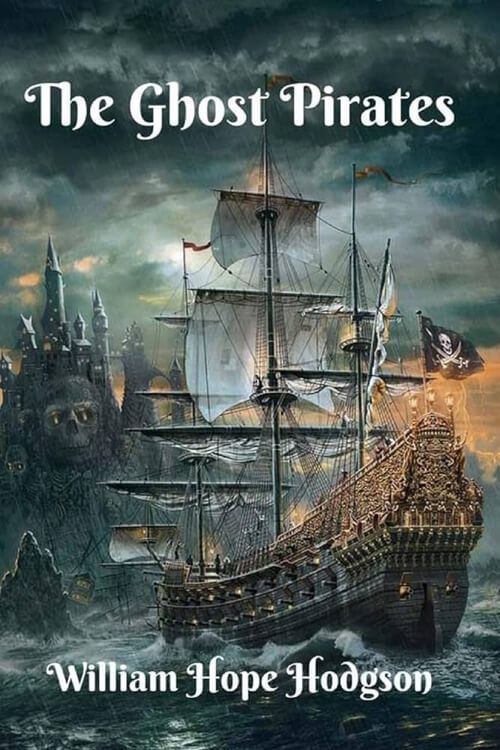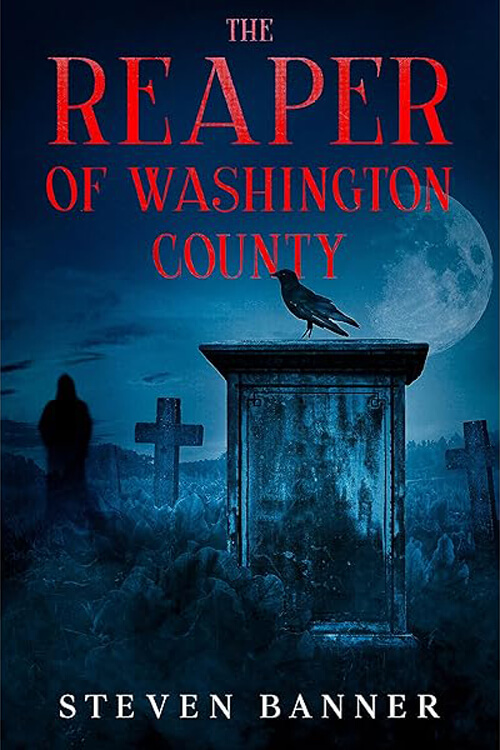
The Ghost Pirates
“What is it?” I asked in an undertone after a couple of moments’ further ineffectual peering. “I can’t see anything.”
“H’sh!” he muttered hoarsely without looking in my direction. Then, all at once, with a quick little gasp, he sprang across the wheelbox and stood beside me, trembling. His gaze appeared to follow the movements of something I could not see.
I must say that I was startled. His movement had shown such terror, and how he stared leeward made me think he saw something uncanny.
“What the deuce is up with you?” I asked sharply. And then I remembered the Second Mate. I glanced forward to where he lounged. His back was still towards us, and he had not seen Tammy. Then I turned to the boy.
“For goodness sake, get to looard before the Second sees you!” I said. “If you want to say anything, say it across the wheelbox. You’ve been dreaming.”
Even as I spoke, the little beggar caught at my sleeve with one hand and, pointing across to the log reel with the other, screamed: “He’s coming! He’s coming——” At this instant, the Second Mate came running aft, singing out to know what was the matter. Then, crouching under the rail near the log reel, I suddenly saw something that looked like a man but was so hazy and unreal that I could scarcely say I saw anything. Yet, like a flash, my thoughts returned to the silent figure I had seen in the flicker of the moonlight a week earlier.
Read or download Book
William Hope Hodgson
William Hope Hodgson (15 November 1877 – 19 April 1918) was an English author. He produced many essays, short fiction, and novels spanning several overlapping genres, including horror, fantastic fiction, and science fiction. Hodgson used his experiences at sea to lend authentic detail to his short horror stories, many of which are set on the ocean, including his series of linked tales forming the “Sargasso Sea Stories”. His novels, such as The House on the Borderland (1908) and The Night Land (1912), feature more cosmic themes, but several of his books also focus on horrors associated with the sea. Early in his writing career, Hodgson dedicated effort to poetry, although few of his poems were published during his lifetime. He also attracted some notice as a photographer and achieved renown as a bodybuilder. He died in World War I at age 40.
Life
Early years and life at sea
Hodgson was born in the hamlet of Blackmore End near Braintree in Essex, the son of the Reverend Samuel Hodgson, an Anglican priest, and Lissie Sarah Brown. He was the second of 12 children, three of whom died in infancy. The death of a child is a theme in several of Hodgson’s works, including the short stories “The Valley of Lost Children”, “The Sea-Horses”, and “The Searcher of the End House”.
Hodgson’s father was moved frequently and served 11 parishes in 21 years, including one in Ardrahan, County Galway, Ireland. This setting was later featured in Hodgson’s novel The House on the Borderland.
Hodgson ran away from boarding school at age 13 to become a sailor. He was caught and returned to his family, but eventually received his father’s permission to be apprenticed as a cabin boy and began a four-year apprenticeship in 1891. Hodgson’s father died shortly thereafter of throat cancer, leaving the family impoverished; while William was away, the family subsisted primarily on charity. After his apprenticeship ended in 1895, Hodgson began two years of study in Liverpool, passed the tests and received his mate’s certificate; he then began several more years as a sailor.
According to Sam Moskowitz, Hodgson experienced bullying at sea, which led him to begin a personal training program.
The primary motivation for his body development was not health but self-defence. His relatively short height and sensitive, almost beautiful face made him an irresistible target for bullying seamen. When they moved in to pulverize him, they would learn too late that they had easily come to grips with one of the most powerful men, pound for pound, in all of England.
His sea stories frequently featured the theme of older seamen bullying an apprentice and taking revenge.
While away at sea, in addition to his exercises with weights and with a punching bag, Hodgson also practised his photography, taking photographs of aurora borealis, cyclones, lightning, sharks, and the maggots that infested the food given to sailors. He also built a stamp collection, practised his marksmanship while hunting, and kept journals of his experiences at sea. In November 1898, he was awarded the Royal Humane Society medal for heroism for saving another sailor who had fallen from the topmast into the sea in shark-infested waters off the coast of New Zealand in March of the same year.
Physical culture, essays and poetry
In 1899, at age 22, he opened a School of Physical Culture in Ainsworth Street, Blackburn, England, as “the inventor and teacher of a system that will cure indigestion”. The School offered tailored exercise regimes for personal training. Among his customers were members of the Blackburn police force. In 1902, Hodgson appeared on stage with handcuffs and other restraining devices supplied by the Blackburn police department and applied the restraints to Harry Houdini, who had previously escaped from the Blackburn jail. His behaviour towards Houdini generated controversy; the escape artist had some difficulty removing his restraints, complaining that Hodgson had deliberately injured him and jammed the locks of his handcuffs.
Hodgson was not shy of publicity and, in another notable stunt, rode a bicycle down a street so steep that it had stairs, an event written up in the local paper. Despite his reputation, he eventually found that he could not earn a living running his personal training business, which was seasonal, and shut it down. He began instead writing articles such as “Physical Culture versus Recreative Exercises” (published in 1903). One of these articles, “Health from Scientific Exercise”, featured photographs of Hodgson himself demonstrating his exercises. The market for such articles seemed to be limited, however; so, inspired by authors such as Edgar Allan Poe, H. G. Wells, Jules Verne and Arthur Conan Doyle,[9] Hodgson turned his attention to fiction, publishing his first short story, “The Goddess of Death”, in 1904, followed shortly by “A Tropical Horror” (1905). He also contributed to an article in The Grand Magazine, taking the “No” side in a debate on “Is the Mercantile Navy Worth Joining?” In this piece, Hodgson details his negative experiences at sea, including salary facts and figures. This led to a second article in The Nautical Magazine, an exposé on apprenticeships; at the time, families often were forced to pay to have boys accepted as apprentices. Hodgson began to give paid lectures, illustrated with his photography in colourized slides, about his experiences at sea.
Although he wrote several poems, only a handful were published during his lifetime; several, such as “Madre Mia” (1907), appeared as dedications to his novels. Cynical about the prospects of publishing his poetry, in 1906, he published an article in The Author magazine suggesting that poets could earn money by writing inscriptions for tombstones. Many of his poems were published by his widow in two posthumous collections, but some 48 poems were not published until their appearance in the collection The Lost Poetry of William Hope Hodgson (2005).
Career in fiction and marriage
Hodgson’s first short story was “The Goddess of Death” (1904), in which he utilised a statue of Flora which stood in Corporation Park, Blackburn, as the focus of a tale in which a Hindu statue seized from an Indian temple, stood in a small English town. The statue comes alive to avenge the people who stole it. The Royal Magazine published the story in April 1904.
In 1906, the American magazine The Monthly Story Magazine published “From the Tideless Sea,” the first of Hodgson’s Sargasso Sea stories. For the remainder of his career, Hodgson continued to sell stories to American and British magazines, carefully managing the rights to his work to maximize his remuneration.
While he still lived with his mother in relative poverty, his first published novel, The Boats of the “Glen Carrig”, appeared in 1907 to positive reviews. Hodgson also published “The Voice in the Night” the same year, as well as “Through the Vortex of a Cyclone”, a realistic story inspired by Hodgson’s experiences at sea and illustrated with tinted slides made from his photographs; Hodgson had previously used these slides to describe a “lantern lecture” entitled “Through the Heart of a Cyclone”, which he had given at the Trinity Wesleyan School in Montague Street, Blackburn, on 16 November 1906. Hodgson also explored the subject of ships and cyclones in his story “The Shamraken Homeward-Bounder” (1908). Also in 1908, Hodgson published his second novel, The House on the Borderland, again to positive reviews, as well as an unusual satirical science fiction story, “Date 1965: Modern Warfare”, a Swiftian satire in which it is suggested that war should be carried out by men fighting in pens with knives, and the corpses carefully salvaged for food, although in letters to the editor published at the time, Hodgson expressed strong patriotic sentiments.
In 1909, he published “Out of the Storm”, a short horror story about “the death-side of the sea”, in which the protagonist drowning in a storm rants about the horrors of a storm at sea. According to Moskowitz,
This story proved an emotional testament beyond all other evidence. Hodgson, whose literary success would be largely based on the impressions he received at sea, hated and feared the waters with an intensity that was the passion of his life.
Also, in 1909, Hodgson published another novel, The Ghost Pirates. In the foreword, he wrote that it
… completes what may be termed a trilogy, for, though very different in scope, each book deals with certain conceptions with an elemental kinship. With this book, the author believes that he closes the door, so far as he is concerned, on a particular phase of constructive thought.
The Bookman magazine, in its review of the novel in 1909, concluded with the comment:
We can only hope that Mr. Hodgson will reconsider his decision, for nothing like the author’s previous work exists in present-day literature.
Despite the critical success of his novels, Hodgson remained relatively poor. To bolster his income from short story sales, he began working on the first of his recurring characters, Thomas Carnacki, featured in several of his most famous stories and partly inspired by Algernon Blackwood’s occult detective, John Silence. The first, “The Gateway of the Monster”, was published in The Idler (1910). In 1910, Hodgson also published “The Captain of the Onion Boat”, an unusual story that combines a nautical tale and a romance. He continued to publish many stories and non-fiction pieces, occasionally resorting to the use of recycled plot elements and situations, sometimes to the annoyance of his publishers.
His last novel to see publication, The Night Land, was published in 1912, although it likely had its genesis several years earlier. Hodgson also worked on a 10,000-word novelette version of the novel, now known as The Dream of X (1912). He continued to branch out into related genres, publishing “Judge Barclay’s Wife”, a Western adventure in the United States, as well as several non-supernatural mystery stories and the science fiction story “The Derelict” (1912), and even war stories (several of the Captain Gault tales feature wartime themes).
In 1912, Hodgson married Betty Farnworth, known also as Bessie, a girl from Cheadle Hulme and a staff member who wrote the “agony” column for the women’s magazine Home Notes. Both were 35. She gave up her job after they married on 26 February 1913 in the London borough of Kensington. They moved south of France and took up residence there, partly owing to the low cost of living. Hodgson began a work entitled “Captain Dang (An account of certain peculiar and somewhat memorable adventures)” and continued to publish stories in multiple genres. However, financial security continued to elude him. When war broke out in Europe, the Hodgsons returned to England.






